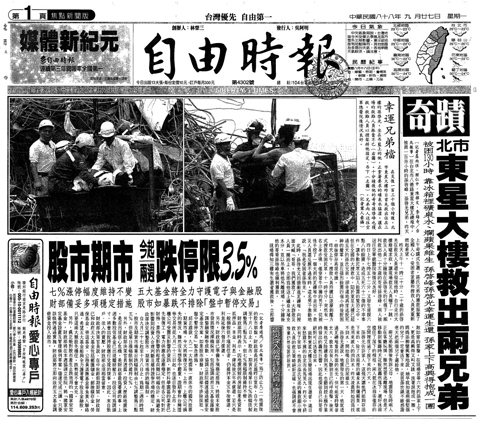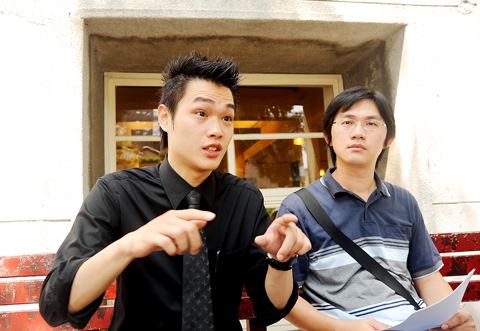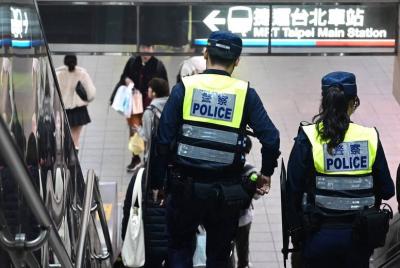Ten years ago, when Sun Chi-kuang (孫啟光) walked out from the wreckage of the Tunghsing building in Taipei after his older brother, Sun Chi-fong (孫啟峰), was lifted out of the rubble six days after the 921 Earthquake, loud cheers erupted from relatives and rescue workers and a new sense of hope emerged.
The Tunghsiung building was the only structure in Taipei City to be completely destroyed by the quake. Eighty-seven people were killed, 105 injured and more than 250 left homeless in the collapse.
During the six days before the younger Sun, who was 19 years of age at that time, dug a tunnel behind a smashed refrigerator and crawled out of the rubble, the two brothers stayed alive by eating rotten apples and drinking stale water and their own urine. In the darkness, they called out each other’s name to confirm their existence and Sun Chi-fong had his 24th birthday celebration under the ruins.

PHOTO: LIU HSIN-DE, TAIPEI TIMES
For many, the morning the younger Sun walked out and yelled “My name is Sun Chi-kuang, a survivor!” was a miracle. For the two brothers, the fear and trauma left by the quake is still alive today.
Ever since the earthquake, the two Suns always place a bottle of water and flashlight at their bedside and always have the light on before going to sleep.
“Ten years on, I am still afraid of earthquakes,” Sun Chi-kuang said.

PHOTO: LIU HSIN-DE, TAIPEI TIMES
The older Sun said memories of the quake and the following six days are still vivid. He and his brother were playing poker when the quake hit their home. They dove under a table, which shielded them from falling debris.
Relatives of the Suns, including the entire family of their aunt, who lived on the fourth floor of the building, did not survive the quake.
As survivors whose miraculous story was broadcast throughout the country, for a long time the two brothers lived with a sense of guilt and enormous pressure as they tried not to fall short of public expectations.
“We’ve been trying to live our lives ... and learned that the best way to repay the kindness and help from those who saved us is to live in the moment,” Sun Chi-fong said while attending a memorial concert organized by Taipei City’s Fire Department in Da-an Park on Saturday.
The older Sun, who is now a computer engineer, would normally celebrate his 35th birthday tomorrow. However, he holds his birthday celebration on Sept. 21 instead.
“I still think about the quake and to me, Sept. 21 is my birthday because me and my brother were reborn on that day” he said.
The two brothers kept a low profile over the years and turned down various interviews and invitations so they could lead a quiet life. On the 10th anniversary of 921, however, they accepted an invitation by the Taipei City Government, not only to thank officers from the Fire Department who rescued them, but also to encourage survivors of Typhoon Morakot through example.

Beijing could eventually see a full amphibious invasion of Taiwan as the only "prudent" way to bring about unification, the US Department of Defense said in a newly released annual report to Congress. The Pentagon's "Annual Report to Congress: Military and Security Developments Involving the People's Republic of China 2025," was in many ways similar to last year’s report but reorganized the analysis of the options China has to take over Taiwan. Generally, according to the report, Chinese leaders view the People's Liberation Army's (PLA) capabilities for a Taiwan campaign as improving, but they remain uncertain about its readiness to successfully seize

Taiwan is getting a day off on Christmas for the first time in 25 years. The change comes after opposition parties passed a law earlier this year to add or restore five public holidays, including Constitution Day, which falls on today, Dec. 25. The day marks the 1947 adoption of the constitution of the Republic of China, as the government in Taipei is formally known. Back then the Chinese Nationalist Party (KMT) governed China from Nanjing. When the KMT, now an opposition party in Taiwan, passed the legislation on holidays, it said that they would help “commemorate the history of national development.” That

Taiwan has overtaken South Korea this year in per capita income for the first time in 23 years, IMF data showed. Per capita income is a nation’s GDP divided by the total population, used to compare average wealth levels across countries. Taiwan also beat Japan this year on per capita income, after surpassing it for the first time last year, US magazine Newsweek reported yesterday. Across Asia, Taiwan ranked fourth for per capita income at US$37,827 this year due to sustained economic growth, the report said. In the top three spots were Singapore, Macau and Hong Kong, it said. South

Police today said they are stepping up patrols throughout the Taipei MRT system, after a social media user threatened to detonate a bomb at an unspecified station this afternoon. Although they strongly believe the threat to be unsubstantiated, Taipei Metro police and the Railway Police Bureau still said that security and patrols would be heightened through the system. Many copycat messages have been posted since Friday’s stabbing attacks at Taipei Main Station and near Zhongshan MRT Station that left three dead and 11 injured, police said. Last night, a Threads user in a post said they would detonate a bomb on the Taipei